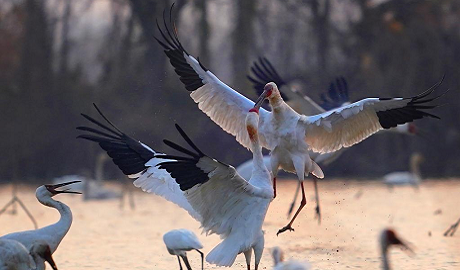

CHANGSHA, Aug. 26 (Xinhua) -- Once an ordinary shoal in the heart of Dongting Lake, China's second-largest freshwater lake in central China's Hunan Province, Tuogan Islet got its name for its resemblance to a tiller and provided key shelter for boats during the Qing Dynasty (1644-1911).
Though the centuries-old stone dock has long disappeared, the islet's unique wetland landscape -- "lake when waters rise, islet when waters fall" -- has made it a crucial wintering site for migratory birds and a key location for ornithological research in Hunan Province.
In 2024, the Forestry Department of Hunan Province launched a two-year action plan to protect migratory birds. As part of the initiative, 91 bird conservation stations are being built or refurbished along major migratory routes, wintering and breeding grounds across the province. One notable project is the Tuogan Islet Station, which is included in this effort.
Over the past year, the station has added 23 all-weather high-definition surveillance cameras, several drones, infrared cameras and a 24-hour patrol team. Hu Caiyan, an official with the local nature reserve administration, said the equipment upgrades and additional personnel have effectively curbed human activities that threaten the birds' habitat. The station has prevented multiple cases of illegal fishing and unauthorized grazing, while restoring hundreds of hectares of degraded wetland.
"Our surveillance system now covers 28,000 mu (about 1,866.7 hectares) of water area in Tuogan Islet. We've captured rare footage we never imagined possible and learned much about migratory bird behavior we didn't previously understand," said Gao Hong, deputy director of the Tuogan Islet Station. One of Gao's everyday tasks is to catalog and archive footage of various waterbirds. Over the course of just a little over a year, he has managed to compile several gigabytes of video data.
Last winter, the surveillance cameras recorded an extraordinary feeding scene of an oriental stork: it repeatedly put a fish into its mouth and then spat it back into the water. The purpose of this exercise was to wash off the mud. In April, they captured footage of five oriental stork chicks hatching -- all of which survived. These videos have been shared with partner research institutions for further analysis.
"In 2021, Tuogan Islet recorded only about 10 species and just over 10,000 individual migratory birds. In the recent winter and spring, that number rose to more than 50 species and over 50,000 birds," said Gao. Notably, populations of first and second-class protected species such as the Baer's Pochard (Aythya baeri) and oriental stork have seen significant growth here. As bird numbers rise and their living conditions improve, the station's role has evolved beyond patrolling and monitoring. In December 2024, Tuogan Islet was once again selected as a key test site, collaborating with Central South University of Forestry and Technology on an experiment to enhance food sources for migratory birds.
"Many areas of Dongting Lake become exposed islets during the dry winter season, allowing large amounts of carex to grow, which is a vital food source for birds," said Lu Weizhi, the university's College of Life Sciences and Technology.
Experimental plots have been set up on Tuogan Islet, where carex is harvested at scheduled intervals. Researchers are studying optimal water levels and plant densities to maximize ecological benefits. Lu hopes the results will lead to technical guidelines for constructing bird food sources in lakes like Dongting and Poyang over the coming years.
The implementation of the two-year migratory bird protection action plan has already shown notable progress. According to the synchronized monitoring data released in March on overwintering waterbirds in Hunan for 2024-2025, a record 71 species and 465,200 birds were counted, both figures setting new highs.
"All 91 bird conservation stations across the province will be completed by the end of this year," said Shi Zhenwei, an official at the Forestry Department of Hunan Province. These stations will provide more accurate data to assess bird populations, distributions, and trends in Hunan, while also supporting foundational research, key technical breakthroughs, and the development of grassroots conservation teams and skilled personnel.

Lianyungang port welcomes largest group of S. Korean travelers under China's visa-free policy

Hall of Mental Cultivation of the Palace Museum reopens to public

Wuyi rock pigment painting in China's Fujian infuses modern artistic elements into tradition

China-Serbia digital art exhibition explores time, space, heritage

点击右上角![]() 微信好友
微信好友
 朋友圈
朋友圈

请使用浏览器分享功能进行分享
